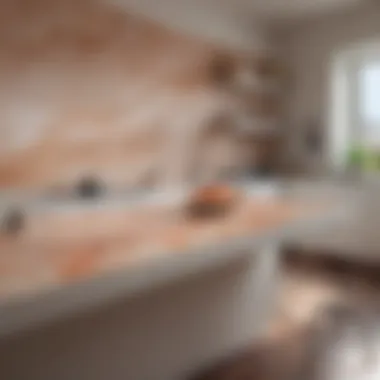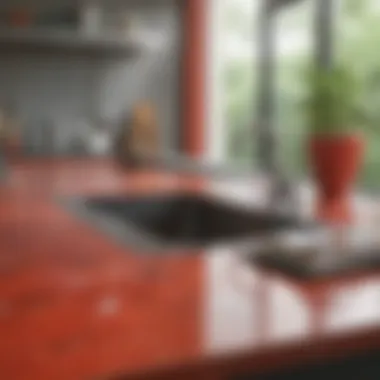Maximizing Formica Countertop Remnants for Style and Use


Intro
In the quest for home renovation, understanding the materials we choose is fundamental. Formica countertop remnants present a unique opportunity for homeowners, designers, and retailers seeking both practicality and aesthetic appeal. These remnants are not simply scraps; they are versatile pieces that can breathe new life into various spaces. As we embark on this exploration, we will uncover the intricacies of these remnants, from their sustainable properties to their design potential.
The rise in eco-consciousness has urged many to reconsider how they use resources, and Formica remnants fit snugly into this trend. With countless applications in mind, this guide serves as a compass, pointing you toward smart decisions in design and sustainability. Let's dive into the current design trends that seamlessly integrate Formica countertop remnants into everyday spaces.
Understanding Formica Countertop Remnants
When talking about home improvement, Formica countertop remnants often flutter around in conversations. Why is it important to understand these materials? Well, for homeowners, designers, and retailers alike, grasping the ins and outs of Formica remnants can unlock plenty of creative possibilities. Whether you are upgrading a kitchen or tackling a small DIY project, having knowledge about what these remnants offer is invaluable.
Definition and Composition
Formica is a brand that has been around since the early 20th century, widely known for its high-pressure laminate surfaces. Countertop remnants are the leftover sections of these surfaces, usually salvaged after a major project. The leftover pieces may have a variety of sizes and designs but share the same essential composition. They're made from layers of paper or fabric that are impregnated with thermosetting resins, creating a durable surface. This mixture of materials gives Formica its characteristic strength and resistance to wear, making it a popular choice at home.
Common Types of Formica Materials
There are several types of Formica materials that can be encountered in the marketplace:
- High-Pressure Laminate (HPL): The most commonly used, often found in residential and commercial settings.
- Post-Formed Laminate: This type can be shaped and molded into various profiles, providing seamless edges.
- Backed Laminate: Usually used for applications where it won’t be subjected to high impact but still requires durability.
Understanding these types helps in choosing the right fitting surviving piece for one’s application, ensuring it meets both aesthetic and practicality needs.
Manufacturing Process of Formica
The manufacturing of Formica involves a rather fascinating process. It starts with the treatment of paper sheets with resin, which, when stacked and compressed under heat, produces the laminate. The steps are as follows:
- Preparation of Layers: Sheets of paper are layered between several resin treatments.
- Pressing: These layers are placed in a hydraulic press to be bonded together, undergoing intense pressure and heat to form a solid unit.
- Finishing Touches: After pressing, these sheets are trimmed, sanded, and cut to specifications.
This meticulous process leads to the reliable product that many recognize as Formica, ensuring each piece has the necessary durability and resistance to daily use.
Understanding these fundamentals not only informs end-users about the qualities of their materials but also helps in making educated choices when selecting countertop remnants.
The Practical Uses of Countertop Remnants
Formica countertop remnants provide an intriguing opportunity for homeowners, designers, and retailers to maximize their materials while minimizing waste. Their versatility opens several doors for creative applications across various spaces. As we dive into the practical uses of these remnants, it's essential to recognize their potential, be it in kitchens, bathrooms, or even in unique furniture projects. Each section elucidates how remnants not only enhance aesthetics but also contribute to a more sustainable approach to interior design.
Kitchen Applications
The kitchen is often termed the heart of the home, and using Formica remnants can breathe new life into this essential space. Here are several applications worth considering:
- Backsplash: Remnants from your Formica countertop can easily be turned into an eye-catching backsplash. It’s an affordable way to add a splash of color or pattern that ties the whole kitchen together.
- Island Top: For those lucky enough to have a kitchen island, remnants can serve as a chic surface that balances usability with style. It enables a continuous design theme while allowing for individuality.
- Shelving: Formica remnants can also be transformed into floating shelves or cabinetry faces. This keeps the design uniform and visually pleasing without breaking the bank.
Consider this:
"Transforming remnants into functional parts of your kitchen not only cuts costs but also recounts a story of resourcefulness."
Bathroom Surfaces
Bathrooms can greatly benefit from the inclusion of Formica remnants. Their durable nature makes them suitable for various applications:
- Vanity Tops: Using remnants to create a custom vanity top can turn your bathroom from mundane to magnificent. You can find a variety of colors and finishes to match your vision.
- Shower Surrounds: With proper sealing, remnants can suit as a moisture-resistant surface for shower walls. This innovation not only prevents costly water damage but also adds a distinctive flair to a regular bathroom.
- Accent Pieces: Smaller remnants can be used for practical purposes, like creating soap dishes or accent frames for mirrors, making the space uniquely yours.


Furniture Projects
Furniture is yet another area where Formica remnants can prove to be invaluable. Engaging in furniture projects with these remnants encourages creativity and can lead to stress-relieving DIY projects:
- Table Tops: A coffee table or dining table can be brilliantly revamped using colorful remnants. This approach showcases individuality while ensuring practicality.
- Cabinet Revamps: Rather than replacing old cabinets, simply applying remnants can astonishingly uplift their appearance. Anyone will agree that a fresh finish can contribute significantly to the overall aesthetic.
Creative Crafts and DIY
Lastly, the realm of creative crafts presents an exciting venue for Formica remnants. Here, imagination knows no bounds:
- Art Projects: If you have a knack for art, remnants can serve as a base for painting or mixed media creations. It represents a canvass that can take on an entirely new life.
- Home Decor Items: Think coasters, picture frames, or even decorative signage for your spaces. These can be made with remnants and can serve as practical and crafty gifts that showcase thoughtful design.
- Kids’ Projects: Invite the children into the mix, letting them create their own masterpieces or useful items to instill a sense of ownership and creativity.
Benefits of Using Formica Remnants
Formica countertop remnants have become a popular option, especially among homeowners, designers, and retailers. Their appeal lies not just in their versatility, but also in the multitude of benefits they offer. When you consider utilizing remnants, you're tapping into a resource that provides substantial value, whether for aesthetic purposes, environmental sustainability, or cost management. Each benefit weaves into the larger narrative of effective design—allowing for creativity while also being budget-conscious.
Cost-Effectiveness
The financial advantages of using Formica remnants are undeniable. First and foremost, choosing remnants often means spending significantly less than you would when purchasing full sheets or slabs. This can be particularly advantageous for smaller projects where full sizes are unnecessary or simply wasteful. By opting for remnants, you can allocate those savings toward other facets of your project, like hardware, installation, or even some finishing touches that can elevate the overall aesthetic.
Furthermore, remnants often come in unique sizes and shapes, which can work perfectly for custom projects—thus eliminating the need for wasteful cutting and fitting that might occur with standard sheets. You’re effectively making smarter financial decisions without compromising on quality. This approach resonates especially well with a community that increasingly values optimal use of resources.
Sustainable Design Choices
In a world that's becoming more eco-conscious, the importance of sustainability in design is paramount. Using Formica remnants contributes positively to environmental health. By selecting remnants, you're participating in a circular economy where existing materials are repurposed rather than disposed of.
"Every bit of remnant you use helps reduce landfill waste and encourages a more sustainable future."
This forward-thinking choice speaks volumes about your commitment to the environment, showcasing how design can coexist harmoniously with ecological responsibility. Additionally, many manufacturers of Formica are now implementing more sustainable practices, such as using recycled materials in their products. Thus, your choice not only aids in minimizing waste but also supports brands that prioritize sustainability.
Variety and Aesthetic Appeal
When it comes to aesthetics, one of the most exciting aspects of using Formica remnants is the sheer variety that can be accessed. Each remnant tells a story of its prior life, along with unique colors, patterns, and textures that are oftentimes not available in current models. This allows for a level of customization that can elevate your living space—infusing character that mass-produced materials often lack.
Moreover, the myriad of design possibilities lends itself well to trending interior styles. Whether you lean toward a minimalist, industrial, or bohemian vibe, finding remnants that complement or contrast those styles is feasible. By thoughtfully selecting remnants, you can achieve a curated look that feels both intentional and fresh.
In closing, leveraging Formica countertop remnants brings a wealth of benefits to the table. From realizing financial savings to supporting eco-friendly initiatives and discovering aesthetic potential, the advantages are manifold. Every bit counts, encouraging both creative exploration and a conscientious approach to home design.
Choosing the Right Formica Remnants
When it comes to renovations or DIY projects, the right material can make all the difference. Formica countertop remnants have become a preferred choice for many due to their versatile applications and aesthetic appeal. However, selecting the right remnants can be a daunting task, especially with numerous factors to consider. Engaging with the nuances of remnants ensures not only that functional needs are met but also enhances the overall visual design of your space. This section will guide homeowners, designers, and retailers through essential considerations for picking the right Formica remnants.
Evaluating Quality and Durability
Quality can vary widely in the world of Formica. It’s crucial to not just go for the first piece that catches your eye. Checking for durability is key. High-quality Formica remnants usually boast a robust construction that can withstand daily wear and tear. When evaluating quality, you might want to look into:
- Thickness: Thicker remnants tend to be more durable, providing better resistance to impacts and scratches.
- Finish: Matte finishes may show wear more readily than glossy options, although they can provide a unique aesthetic.
- Overall Condition: Scrutinize for any blemishes, scratches, or discolorations that might affect both the appearance and lifetime of the material.
Remember, you want your design to withstand the test of time rather than becoming an eyesore.
Sizing and Availability
Next on the checklist is sizing. Not all remnants fall into the same dimensions, which can significantly impact your project. Confirming the availability of specific sizes allows you to plan more effectively. Key points to consider include:
- Standard Dimensions: Typically, remnants come in various sizes from small strips to larger sheets. Know the dimensions you need ahead of time.
- Handling Cutouts: If you need cutouts for sinks or cooktops, ensuring the remnant can accommodate these changes is vital.
- Local Availability: Keep in mind that remnants may differ based on supplier inventory. It can pay off to get to know local fabricators or suppliers to scout what they have on hand.


Color and Pattern Selection
Now, let's talk about color and patterns. This is where the fun begins, as the right shade or design can transform your space dramatically. When choosing, consider the following:
- Complement Your Concept: Think about the overall color scheme of your kitchen or bathroom. Do you aim for a bold contrast, or is a subtle harmony more your style?
- Patterns and Textures: Formica comes in a wide range of patterns, from minimalist designs to vibrant motifs. Consider how patterns interact with light, as this can drastically alter the ambiance.
- Samples Matter: Always request samples before you commit. Often, colors and patterns look different in various lighting conditions. Checking a piece in the planned environment helps to ensure coherence with your design.
"When in doubt, always go for what resonates with you. Design is personal and should reflect your taste and personality."
Making the right choices while selecting Formica remnants involves careful consideration. By keeping quality, size, and aesthetic preferences in mind, you can ensure that your project is not just functional, but also pleasing to the eye.
Design Ideas Using Formica Countertop Remnants
In the realm of interior design, versatility is often the name of the game. Formica countertop remnants present an excellent opportunity to leverage both functionality and aesthetics without breaking the bank. By utilizing these remnants, homeowners and designers can achieve stunningly unique results, all while making a conscious choice for sustainability. This section will explore various creative applications of Formica remnants, dissecting their effectiveness in kitchen designs, integration with existing décor, and even some unexpected uses that might surprise even the most seasoned decorators.
Innovative Kitchen Designs
The kitchen is often termed the heart of the home, and a well-designed space can transform not just the room but the entire atmosphere of a house. When it comes to Formica countertop remnants, the possibilities are seemingly endless. Designers can use remnants to create eye-catching islands or bold backsplashes that stand out against cabinetry or appliances.
A key element to consider is color coordination. For instance, a vibrant red or deep navy Formica can add a pop of color in an otherwise muted kitchen. Additional patterns can also inject personality; think geometric shapes or intricate designs, which might make a simple surface feel like a piece of art rather than just a workspace.
“Using remnants innovatively allows for a unique kitchen experience. A touch of creativity can go a long way.”
Furthermore, one can get crafty with mixed materials, pairing Formica with wood or metal elements. This juxtaposition can soften the rigidity of stone or metal counterparts, creating an inviting yet modern look. By layering textures and styles, designers can engineer a kitchen that is not just functional but visually arresting.
Coordinating with Existing Decor
One of the significant advantages of using Formica remnants is their adaptability to various styles of decor. Homeowners often grapple with how new elements will mesh with their current design, especially if the theme is well established. The beauty of Formica lies in its extensive range of colors, patterns, and finishes, making it easier to select remnants that complement other materials in the space.
For those who have a minimalist aesthetic, smooth, matte finishes in neutral tones can harmonize beautifully with existing furnishings, blending seamlessly into the overall design. Conversely, if the decor leans toward a bohemian flair, lively patterns and textures can become focal points that enhance the room's vibrancy.
Creating a coherent look also includes paying attention to details. For instance, if a homeowner has ceramic tiles in certain hues, choosing Formica remnants that echo those colors can bring unity to the design. Consider using Formica not only for countertops but also for shelving or accent pieces to tie the look together. This approach ensures that remnants serve a dual purpose: function and aesthetics.
Unexpected Uses in Home Decor
Creativity knows no bounds when it comes to using Formica remnants in home decor. Beyond countertops, these remnants can be transformed into striking home accents that breathe new life into various spaces. For instance, a homeowner might consider using Formica sheets to create unique wall art or striking picture frames.
Another unexpected but innovative use is in crafting custom tabletops or desks. A simple plywood base, topped with a remnant, can yield a unique statement piece that adds personality to an office or dining room. Additionally, consider applying Formica to furniture refurbishing projects, turning outdated pieces into chic, modern treasures.
In sum, Formica remnants hold the potential for not just practical applications but also the ability to incite creativity in interior décor. They embody a collision of sustainability and style, ensuring that every inch utilized is both environmentally friendly and visually appealing.
Environmental Considerations
Understanding the environmental impact of materials we use in our homes is crucial in today’s world. Formica countertop remnants, while often celebrated for their style and affordability, also hold significance in the realm of sustainability. The way we source these materials, their lifecycle, and subsequently how we dispose of them all play vital roles in reducing our ecological footprint.
Sourcing and Sustainability
When it comes to sourcing Formica remnants, it's essential to consider where and how these materials are produced. Many manufacturers are increasingly leveraging recycled content in their products. This not only helps reduce waste but also minimizes resource extraction. Using remnants can mean purchasing from local suppliers, cutting down on transportation-related emissions.
Selecting remnants can also encourage responsible practices among vendors. When designers and homeowners prioritize sourcing sustainable products, it sends a message to suppliers about the importance of green practices. Here are a few key points to consider:
- Look for certifications: Certifications such as GreenGuard or FSC can indicate that the product adheres to environmental standards.
- Opt for local sources: Local suppliers often have a smaller carbon footprint.
- Research the manufacturing process: Understanding how Formica is made can provide insight into its environmental impact.
This approach not only supports a healthier planet but also allows for unique selections that can add character to a home.
Lifecycle of Formica Products
Examining the lifecycle of Formica products sheds light on the benefits and drawbacks at each stage. From production to disposal, every phase has implications for the environment.


- Production: The manufacturing process of Formica can involve chemicals, and some substances might not be environmentally friendly. However, modern advancements are improving this aspect significantly, focusing on reducing emissions and waste.
- Usage: Once installed, Formica surfaces are durable and long-lasting. They require minimal maintenance, meaning that they won’t need to be replaced frequently, which is advantageous from a sustainability standpoint.
- End-of-life: When a Formica countertop reaches the end of its life, what happens next? This part of the lifecycle is critical. Knowing how to properly recycle or dispose of these materials can affect resource conservation efforts.
Thus, being mindful of the entire lifecycle helps consumers make informed choices that align with sustainability goals.
Recycling and Disposal Options
Proper recycling and disposal of Formica remnants can significantly reduce waste. Unfortunately, many do not know how to go about these processes. Here are some options to consider:
- Check local recycling programs: Some communities have specialized recycling programs for composite materials, including Formica.
- Donate: Unused remnants can be donated to local schools, community centers, or workshops for crafting projects.
- Contact the manufacturer: Some manufacturers have take-back programs meant to ensure eco-friendly disposal of their products.
"Proper recycling is not just about reducing waste; it’s about giving materials a second life and conserving the earth’s resources."
When it comes to disposal, the goal should always be to minimize harm and maximize reuse. By familiarizing yourself with these options, you contribute not only to creating a more sustainable environment but also promote the cyclic economy of materials used in your home.
Maintenance and Care for Formica Surfaces
Taking care of Formica surfaces is not just about aesthetics; it plays a significant role in their longevity and performance. Understanding how to properly maintain and care for these surfaces can ensure that they remain looking sharp and functioning effectively over time. Given how versatile these remnants can be, proper upkeep is crucial for homeowners, designers, and retailers alike.
Cleaning Techniques
Keeping your Formica surfaces clean is quite simple, but it requires specific methods to avoid causing any damage. Here’s a breakdown of effective cleaning techniques:
- Regular Wiping: Use a soft cloth or sponge with warm, soapy water for daily maintenance.
It’s best to stick to mild dish soap mixed with water to keep the surface pristine. Avoid abrasive pads or scrubbers, as they might leave scratches. - Stain Removal: For tough stains, a paste of baking soda and water can work wonders. Apply it gently on the stain, let it sit for a few minutes, then wipe it away. This method is effective in eliminating residue without harming the finish.
- Avoiding Harsh Chemicals: When tackling deeper cleaning, steer clear of bleach or ammonia-based cleaners. They may discolor and damage the laminate over time. Instead, opt for a vinegar-water solution, as it's effective yet gentle on the surface.
Remember, keeping the surface dry is equally important. After cleaning, make sure to dry the surface with a clean towel to prevent water spots or stains.
"Regular care can extend the lifespan of your Formica, turning a budget-friendly choice into a long-term investment."
Preventing Damage and Wear
Proactively preventing damage is essential when it comes to maintaining your Formica surfaces. Here are several thoughtful strategies:
- Heat Protection: Always use trivets or heat pads for hot cookware. While Formica is heat-resistant to a degree, high temperatures can cause it to warp or crack.
- Sharp Object Guidelines: Avoid cutting directly on the surface. Use cutting boards instead. Not only does this protect the laminate, but it also keeps knives from dulling quickly.
- Placement Awareness: When positioning items on your Formica countertop, consider the weight and material of those items. Heavy appliances can create stress points, while articles with rough bottoms can scratch the surface if moved.
- Opacity and Staining: Regularly check for any signs of discoloration. If any areas appear to be fading, it could be a signal to refresh your care routine or reassess the items placed on those spots.
Ultimately, understanding these simple yet effective maintenance practices ensures your Formica surfaces look fresh and continue to serve you well for years to come.
Maintaining your Formica countertops transcends mere cleaning; It’s about nurturing them to enhance the longevity and beauty of your living spaces while retaining the investment value you've made.
Final Thoughts on Formica Countertop Remnants
The exploration of Formica countertop remnants highlights their potential and versatility in a variety of applications. As homeowners and designers seek to balance aesthetic appeal with functionality, remnants present an economical yet chic solution. Understanding how these materials can transform spaces empowers the users to make informed decisions.
Remnants are not just leftover pieces; they embody sustainable choices, offering a dual benefit of style and environmental consciousness. By repurposing these materials, one contributes to the reduction of waste, which resonates with increasing consumer awareness regarding sustainability.
In summary, the key elements that stand out in this discussion revolve around practicality, aesthetic adaptability, and environmental stewardship. Whether renovating a kitchen or tackling a DIY project, Formica remnants provide an accessible option that doesn’t compromise on looks.
"Using remnants encourages creativity and showcases personal style, all while being kind to the planet."
Summary of Key Points
- Understanding the Composition: Knowing what Formica is made from can help in assessing its quality and fit for different purposes.
- Practical Applications: From kitchen counters to unique home decor, remnants can serve a multitude of roles.
- Advantages of Usage: They offer cost-effectiveness and sustainability, making them a smart choice.
- Selecting the Right Remnants: Quality, size, color, and durability are crucial factors to consider when choosing.
- Innovative Design Ideas: Formica can enhance aesthetics in unexpected ways, inviting creativity into design spaces.
- Environmental Impact: Choosing remnants is a step towards eco-friendliness, reducing waste and promoting greener practices.
Future Trends in Material Usage
As we look toward the future, several trends are emerging in the realm of countertop materials, particularly with Formica remnants.
- Eco-Conscious Choices: There’s a growing trend of using sustainable materials, which aligns perfectly with the ethos of repurposing Formica remnants. Consumers want to know that their choices reflect their environmental values.
- Customized Designs: Customized options are becoming increasingly popular. With Formica, people can create unique designs that suit their personal tastes while utilizing remnants admirably.
- Integration of Technology: Advances in technology will likely lead to new finishes and textures for Formica, making it an ever-more appealing option for homeowners.
- Collaboration with Artists: There’s potential for partnerships between designers and artists to create bespoke pieces that draw attention to the artistic side of using remnants in home projects.
These trends signify that the landscape of interior design is shifting toward more sustainable and personalized choices. In that vein, Formica remnants are positioned strongly to play a significant role in future home design practices, appealing to a discerning and conscientious audience.



